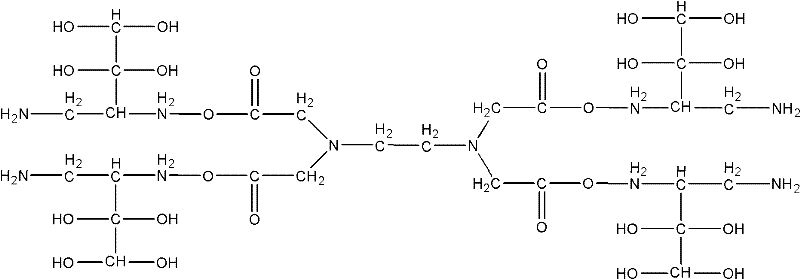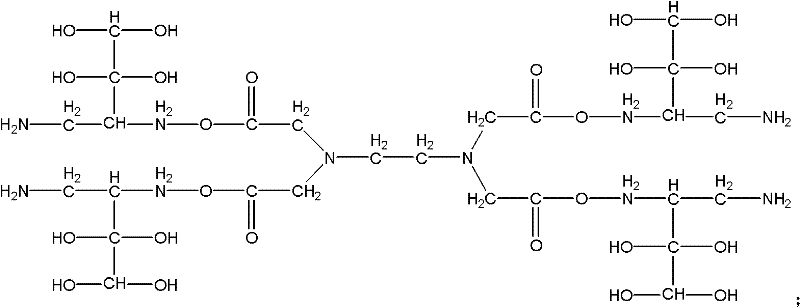Surface cleaning method for Ti barrier layer material subjected to chemically mechanical polishing
A chemical-mechanical and barrier-layer technology, applied in chemical instruments and methods, cleaning methods using liquids, cleaning methods and utensils, etc., can solve the problem of uneven distribution of polishing liquid, contamination of metal ions, reduced device yield, and high surface temperature. problems, to achieve the effect of preventing local continuous reaction, good temperature consistency, and reducing damage layer
- Summary
- Abstract
- Description
- Claims
- Application Information
AI Technical Summary
Problems solved by technology
Method used
Image
Examples
Embodiment 1
[0026] (1) Take 497g of ultrapure water with a resistance of 18MΩ, add 2.5g of surfactant FA / OI type surfactant and 0.5g of FA / O II type chelating agent while stirring, and get a pH value of approximately 6.7 after stirring evenly It is a neutral water-soluble surface cleaner.
[0027] (2) Use the cleaning liquid obtained in step (1) to quickly polish and clean the Ti barrier layer material after alkaline chemical mechanical polishing, with a flow rate of 1000ml / min and a pressure of zero pressure (self-weight pressure), and polishing and cleaning for 30s.
[0028] (3) Dilute 0.5 g of benzotriazole corrosion inhibitor with resistance of 18 MΩ ultrapure water 499.5, quickly carry out zero pressure (self-weight) to the Ti barrier layer material after step (2) cleaning with the diluted benzotriazole solution Pressure) polishing cleaning, the flow rate is 1000ml / min, and the polishing cleaning time is 30s.
[0029] (4) Rinse the Ti barrier layer material cleaned in step (3) for 3...
Embodiment 2
[0032] (1) get the ultrapure water 2054g that resistance is 18MΩ, add surfactant O while stirring π -1042g and 38g of FA / O II type chelating agent, after stirring, the pH value obtained after stirring is 6.9 and is approximately neutral water-soluble surface cleaning liquid.
[0033] (2) Use the cleaning liquid obtained in step (1) to quickly polish and clean the Ti barrier layer material after alkaline chemical mechanical polishing, with a flow rate of 1600ml / min and a pressure of 0.01 atmosphere, and polishing and cleaning for 80s.
[0034] (3) Dilute the hexamethylenetetramine corrosion inhibitor 38g with the ultrapure water 2096g of 18MΩ with the resistance, quickly carry out zero to the Ti barrier layer material after step (2) cleaning with the hexamethylenetetramine solution after dilution Pressure (self-weight pressure) polishing cleaning, the flow rate is 1600ml / min, and the polishing cleaning time is 80s.
[0035] (4) Rinse the Ti barrier layer material cleaned in st...
Embodiment 3
[0038] (1) Take 5643.56g of ultrapure water with a resistance of 18MΩ, add 12.42g of surfactant O-202 and 212.42g of FA / O II type chelating agent while stirring, and get a pH value of 7.3 after stirring evenly, which is approximately neutral. Non-toxic surface cleaner.
[0039] (2) Use the cleaning liquid obtained in step (2) to quickly polish and clean the Ti barrier layer material after alkaline chemical mechanical polishing, with a flow rate of 2800ml / min and a pressure of 0.005 atmospheres, and polishing and cleaning for 130s.
[0040] (3) Dilute the hexamethylenetetramine corrosion inhibitor 212.42g with the ultrapure water 5855.98g of the resistance of 18MΩ, and quickly clean the Ti barrier layer material after the step (2) with the diluted hexamethylenetetramine solution Carry out zero-pressure (self-weight pressure) polishing and cleaning, the flow rate is 2800ml / min, and the polishing and cleaning time is 130s.
[0041] (4) Rinse the Ti barrier layer material cleaned...
PUM
| Property | Measurement | Unit |
|---|---|---|
| electrical resistance | aaaaa | aaaaa |
| density | aaaaa | aaaaa |
| melting point | aaaaa | aaaaa |
Abstract
Description
Claims
Application Information
 Login to View More
Login to View More - R&D
- Intellectual Property
- Life Sciences
- Materials
- Tech Scout
- Unparalleled Data Quality
- Higher Quality Content
- 60% Fewer Hallucinations
Browse by: Latest US Patents, China's latest patents, Technical Efficacy Thesaurus, Application Domain, Technology Topic, Popular Technical Reports.
© 2025 PatSnap. All rights reserved.Legal|Privacy policy|Modern Slavery Act Transparency Statement|Sitemap|About US| Contact US: help@patsnap.com


